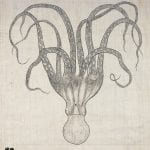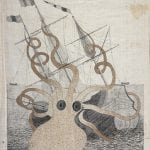
When I was thinking about what I wanted to write for this post, it occurred to me to talk about my interaction with the collections we have here, outside of my official role as a software developer. In my role here, I’m responsible for the images and metadata getting ingested into our digital asset management system and also keeping that website going day to day. Thinking about this work made me ask myself the question: how has working here changed me? Or, better yet, what are the side effects of this position on my interests?
Generally side effects are unwanted or unexpected or unhoped for things. Like, for example, my regular expression grabbing too many files and ingesting them under another record (see an example of a regular expression here). It was a bad side effect of something that worked most of the time, until a different scenario showed up. But side effects are not always negative so I’ve found, and in being here and looking at the images from artifacts in the Archives and Special Collections each day, I discovered that I’ve grown fond of the items in our collections.
So in that line of thinking, here are some of the side effects I’ve noticed in myself as a result of working here.
One side effect is an interest in the collections themselves. While an ingest is running, I generally keep an eye on what’s happening by making sure new items appear on our website every few minutes. Spot check things, if you will. It’s a fun process and you never know what might show up. Or what you might get sucked into. Or what might have just broke because of the aforementioned regular expression.
What shows up is not random, however, but to me it’s all new as I’m generally only involved in the last phase of the process of getting data into the digital repository. I didn’t play a part in creating the images or generating the metadata, so for me I’m seeing the collections for the first time. The results of many hours of hard work done by my colleagues are finally shared with the world.
(note: if you click on an image below you’ll be taken to ACDC, our Amherst College Digital Repository, where you can then click on the image to zoom in. You can also explore other parts of the collection there as well.)
Recently we ingested a bunch of photographs taken by various college photographers over the years. Here’s one that caught my attention almost immediately.

It’s of some cast members performing Pygmalion and the images are joyous to peruse. I find myself going back to it from time to time and I wish I could have been there to see this particular performance.
Then there are some great photos of Frost Library from the 70’s. You do remember card catalogs, yes?

How about this gem from when the college moved the library out of Converse Hall and into Frost library in 1965? I’m pretty sure you couldn’t do it quite like this anymore:

There are such great stories here, among this collection, that I hope the people in the photos find their way into the photographers collection and take a walk down memory lane.
Another side effect: I’ve become smarter. Well, okay, that’s questionable. But items have piqued my curiosity a bit. It’s because there are records that capture your attention merely by title, and then I just have to look up more about it if I don’t immediately know what it is. Like Phrenology:

And, what is a daguerreotype anyways?

And in looking at records like that Phrenology one, I’ve become an advocate for students learning how to write in cursive. They still teach cursive writing in schools in the US, but just barely. And I’ve heard that students usually have a hard time reading the writing in documents like the one above. It is especially challenging if you’ve never been taught how to write in cursive, it’s almost a different language. So, I’ve added one more thing to the list of things my kids need to learn…
Lastly, I’ve developed an appreciation for just admiring the artwork that’s in our collections. I’ll leave you with a few of my favorite images in the collections. These were drawn by Orra White Hitchcock.
Bethany Seeger is a software developer working in the Amherst College library, focusing mainly on the Amherst College Digital Repository. She can be reached at bseeger@amherst.edu.



